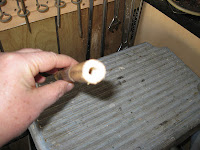My goal was to reproduce this hotel with materials from my yard. http://www.terrevivante.org/237-construire-un-hotel-a-inscetes.htm
In addition to the bumble bee box and holes drilled in wood, I also needed some other tubular structures that bees might like to nest in. Many designs use bamboo poles for this. After a trip to Lowe's to supplement my existing inventory, I cut the poles into 5.5" lengths. This corresponds to the width of the shelving I was using as part of the structure.
Since bees use mud to seal their nests, I purchased a kitty water and put it near the structure. I filled the bowl with soil and made really nice mud. The automatic waterer should keep it moist during our hot weather (as long as I keep the reservoir full!) Hopefully butterflies will use it for mud-puddling too.
The lacewing house became the biggest challenge. Everything I could find said to use corrugated cardboard rolled into a cylinder. Just a few years ago, this would not have been a problem. Trouble is that cardboard has been completely replaced by bubble wrap. Even my shipping department husband couldn't score me any type of cardboard that I could easily roll.
I decided to go ahead and try the bubble wrap. I worry that it will not have the right air circulation, but it's worth the experiment. I rolled a layer of newspaper with it to try to emulate cardboard - we'll see if that works.
I made a plywood box to hold the rolls. The slits in front were made with a jig saw.
Many plans call for some sort of clay or mud bricks for solitary bees to nest in. I have a bunch of 4" pots so I thought I could just fill them with mud and let them dry in the hot Texas sun. However, one of my master gardener friends now sells coconut fiber bricks. I bought two from him and used the coconut fiber to fill these square pots. I cut the top rim off one pot so it will nest in the other. The holes at the bottom make great entry points.
 The shelf unit I used had two shelves that were just the right height to tuck these pots into. I used some cedar shakes to make sure they were crammed in there tightly.
The shelf unit I used had two shelves that were just the right height to tuck these pots into. I used some cedar shakes to make sure they were crammed in there tightly.
Now that I have all the nesting structures built - we can assemble it! More on that in my next post.








No comments:
Post a Comment